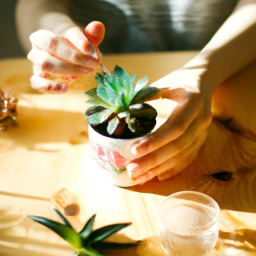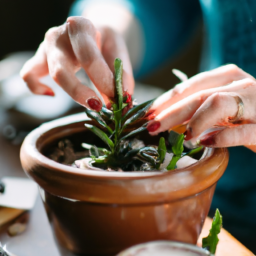
Hey there! Are you a succulent enthusiast looking to level up your plant care game? Well, you’ve come to the right place! In this blog post, we’ll be diving into the wonderful world of succulents and sharing some expert tips on how to care for these beautiful and low-maintenance plants. So, whether you’re a seasoned succulent lover or just starting out on your green thumb journey, get ready to learn all about the care for a succulent and how to keep these little beauties thriving in your home or garden. Let’s get started, shall we?
Selecting the Right Soil and Pot for Your Succulent
Welcome to our comprehensive guide on caring for succulents! Succulents are fascinating plants that have gained immense popularity due to their unique beauty and low maintenance requirements. In this article, we will walk you through the essential steps of selecting the right soil and pot for your succulent, ensuring their optimal growth and longevity.
Understanding the Importance of Soil Composition
The first crucial aspect to consider when caring for your succulent is the soil composition. Succulents thrive in well-draining soil that allows excess water to flow through easily, preventing root rot and other moisture-related issues. The ideal soil for succulents should be loose, porous, and have excellent drainage capabilities.
One common mistake many succulent enthusiasts make is using regular potting soil, which tends to retain moisture for longer periods. This can lead to overwatering and ultimately harm your succulent. Instead, opt for a specialized succulent or cactus soil mix, readily available at most garden centers or online. These mixes are specifically formulated to meet the unique needs of succulents, providing the right balance of moisture retention and drainage.
Alternatively, you can create your own succulent soil mix by combining equal parts of regular potting soil, coarse sand, and perlite. This DIY approach allows you to customize the soil composition based on the specific requirements of your succulent species.
Choosing the Perfect Pot for Your Succulent
Now that you have the right soil mix, it’s time to choose the perfect pot for your succulent. The pot you select plays a crucial role in maintaining the overall health and well-being of your plant. Here are some factors to consider:
1. Size: Succulents generally prefer snug pots that are slightly larger than their root ball. A pot that is too large can retain excess moisture, increasing the risk of root rot. Ensure there is enough room for the roots to grow, but avoid oversized containers.
2. Material: Terracotta pots are often recommended for succulents due to their porous nature, allowing for better airflow and moisture evaporation. However, ceramic and plastic pots can also be suitable as long as they have proper drainage holes.
3. Drainage: Proper drainage is vital for succulent health. Ensure your chosen pot has drainage holes at the bottom to prevent water from pooling and causing root rot. If you fall in love with a pot that lacks drainage holes, you can create them yourself using a drill or consider using it as an outer decorative pot while placing your succulent in a well-draining inner pot.
4. Aesthetics: Lastly, consider the aesthetic appeal of the pot. Succulents come in various shapes, sizes, and colors, so selecting a pot that complements their unique characteristics can enhance the overall visual appeal of your plant.
Repotting Your Succulent
Once you have chosen the right soil and pot, it’s essential to repot your succulent correctly. Repotting helps refresh the soil, provides additional space for root growth, and promotes overall plant health. Here’s a step-by-step guide on repotting your succulent:
Step 1: Carefully remove the succulent from its current pot by gently loosening the soil around the edges. Be cautious not to damage the roots.
Step 2: Inspect the roots for any signs of damage or rot. Trim off any unhealthy or mushy roots using sterilized pruning shears.
Step 3: Prepare the new pot by filling it with the appropriate succulent soil mix, leaving enough space for the root ball to fit comfortably.
Step 4: Place the succulent in the new pot, ensuring the top of the root ball is level with the pot’s rim. Gently fill the gaps with soil, pressing it down lightly to secure the plant.
Step 5: Water the newly repotted succulent lightly, allowing the soil to settle. Avoid overwatering during the first few days to prevent root rot.
Congratulations! You have successfully selected the right soil and pot for your succulent and learned how to repot it effectively. Remember to place your newly potted succulent in a location that receives adequate sunlight and provide regular but controlled watering. With proper care, your succulent will thrive and bring you joy for years to come!

Essential Watering Tips for Succulent Care
When it comes to caring for succulents, watering is a crucial aspect that can greatly impact their overall health and longevity. Succulents are known for their ability to store water in their leaves, stems, and roots, making them well-adapted to survive in arid conditions. However, improper watering can lead to various issues such as root rot or dehydration. In this guide, we will delve into the essential watering tips to ensure your succulents thrive.
Understanding Succulent Watering Needs
Before we dive into the watering tips, it’s important to understand the unique watering needs of succulents. Unlike other houseplants, succulents prefer infrequent but deep watering. Their thick leaves and water-storing capabilities allow them to withstand periods of drought. Overwatering is a common mistake that succulent enthusiasts make, as it can lead to root rot and other fungal diseases.
One way to determine if your succulent needs watering is by checking the soil moisture level. Stick your finger about an inch into the soil, and if it feels dry, it’s time to water. Remember, it’s always better to underwater than to overwater your succulents.
Now, let’s move on to the essential watering tips for succulent care:
1. Water Deeply and Allow Proper Drainage
When watering your succulents, it’s crucial to provide a thorough soak. This ensures that the water reaches the roots and encourages healthy growth. Use a watering can or a gentle stream of water to saturate the soil until it starts to drain from the bottom of the pot. Allow the excess water to fully drain out, as succulents are susceptible to root rot if they sit in standing water for too long.
2. Adjust Watering Frequency Based on Season and Environment
Succulents have different watering needs depending on the time of year and their environment. During the active growing season, which is typically spring and summer, succulents require more frequent watering. However, in the dormant period, which is usually winter, they need less water as their growth slows down. Additionally, if your succulents are placed in a humid environment, they will require less watering compared to those in a dry climate.
3. Use the “Soak and Dry” Method
The “soak and dry” method is a popular technique among succulent enthusiasts. It involves thoroughly watering the soil until it’s saturated and then allowing it to dry out completely before watering again. This method mimics the natural rainfall patterns in succulents’ native habitats, promoting healthy root development and preventing waterlogged soil.
4. Avoid Watering the Leaves
When watering succulents, it’s important to focus on the soil rather than the leaves. Water droplets on the leaves can magnify sunlight and cause sunburn or scorch marks. Additionally, wet leaves can create a favorable environment for fungal diseases. Direct the water towards the base of the plant, aiming for the soil.
5. Consider Using a Well-Draining Soil Mix
Succulents thrive in well-draining soil that allows excess water to escape quickly. Consider using a specialized succulent or cactus potting mix, which usually consists of a combination of sand, perlite, and porous materials. This type of soil mix prevents water from pooling around the roots, reducing the risk of root rot.
6. Watch for Signs of Overwatering or Underwatering
Lastly, it’s important to monitor your succulents for signs of overwatering or underwatering. Overwatered succulents may develop yellow or translucent leaves, mushy stems, or a foul odor. On the other hand, underwatered succulents may have shriveled leaves, wrinkled stems, or become discolored. Adjust your watering routine accordingly if you notice any of these signs.
In conclusion, proper watering is vital for the health and well-being of your succulents. Remember to water deeply, adjust watering frequency based on the season and environment, use the “soak and dry” method, avoid watering the leaves, consider well-draining soil, and watch for signs of overwatering or underwatering. By following these essential watering tips, you can ensure that your succulents thrive and bring beauty to your space for years to come.

Protecting Your Succulent from Sunburn and Overexposure
When it comes to caring for your succulent, one crucial aspect that often gets overlooked is protecting it from sunburn and overexposure. Succulents are known for their ability to thrive in bright light conditions, but just like us, they can get sunburned if exposed to intense sunlight for prolonged periods. In this guide, we will explore the importance of shielding your succulent from excessive sunlight and provide you with some valuable tips to ensure its healthy growth.
Understanding Sunburn in Succulents
Sunburn in succulents occurs when the plant is exposed to direct sunlight for too long without any protection. The intense heat and UV rays from the sun can cause damage to the plant’s tissues, leading to discoloration, scarring, and even death in severe cases. It’s essential to be mindful of the amount of sunlight your succulent receives and take necessary measures to shield it from overexposure.
One of the first signs of sunburn in succulents is a change in color. You may notice patches of white, yellow, or brown on the leaves, indicating that the plant is getting too much direct sunlight. Additionally, sunburned succulents may develop a wilted or shriveled appearance, as the excessive heat can cause dehydration and damage the plant’s ability to retain moisture.
To protect your succulent from sunburn, follow these steps:
1. Find the Right Sunlight Exposure
Each succulent species has its own sunlight requirements, so it’s crucial to understand the specific needs of your plant. Some succulents thrive in full sun, while others prefer partial shade. Research the optimal sunlight conditions for your particular succulent and place it accordingly. If you’re unsure, observe how your succulent reacts to different light conditions and make adjustments accordingly.
2. Gradually Introduce Your Succulent to Sunlight
If you’ve recently purchased a succulent or moved it to a different location, it’s essential to acclimate it to direct sunlight gradually. Sudden exposure to intense sunlight can shock the plant and increase the risk of sunburn. Start by placing your succulent in a location with bright, indirect light for a few hours each day, gradually increasing the exposure over a week or two. This will help the plant adjust to the new light conditions and minimize the risk of sunburn.
3. Use Shade Cloth or Sheer Curtains
If your succulent is receiving too much direct sunlight, you can provide some shade using shade cloth or sheer curtains. These materials will reduce the intensity of the sunlight while still allowing enough light for the plant to thrive. Attach the shade cloth or curtains to a frame or place them strategically to create a shaded area for your succulent. Remember to choose a shade cloth with an appropriate density to ensure the right amount of light reaches your plant.
4. Rotate Your Succulent
To ensure even growth and prevent one side of your succulent from getting more sunlight than the other, rotate the plant periodically. This will help all parts of the succulent receive an equal amount of light, reducing the risk of sunburn on specific areas. Aim to rotate your succulent every two to four weeks, especially if it’s placed near a window or under grow lights.
5. Water Your Succulent Properly
Proper watering is essential for succulents to thrive and maintain their resilience against sunburn. Overwatering can make the plant more susceptible to sunburn, as it can weaken the tissues and reduce its ability to withstand heat. Ensure that you follow a well-balanced watering schedule, allowing the soil to dry out completely between waterings. This will help the succulent stay healthy and better tolerate sunlight.
6. Consider Protective Coatings
For succulents that are particularly sensitive to intense sunlight, applying a protective coating can be beneficial. There are various products available in the market, such as sunburn protection sprays or anti-transpirants, that create a thin barrier on the plant’s leaves, reducing the impact of UV rays. However, it’s important to research and choose a product specifically designed for succulents, as some coatings may harm the plant instead of protecting it.
By following these steps, you can ensure that your succulent remains protected from sunburn and overexposure. Remember, each succulent is unique, so it’s crucial to observe and understand the specific needs of your plant. With the right care and attention, your succulent will thrive and bring beauty to your space for years to come.
Here’s what we learned
Succulents have become increasingly popular in recent years, and it’s no surprise why. These low-maintenance plants not only add a touch of greenery to any space but also bring a unique and trendy aesthetic. If you’re thinking of adding a succulent to your collection, it’s important to know how to care for it properly to ensure its longevity and health.
First and foremost, succulents thrive in bright, indirect sunlight. Find a spot near a window where they can receive a few hours of sunlight each day. However, be cautious of placing them in direct sunlight as it can scorch their leaves. When it comes to watering, succulents are drought-tolerant, so it’s best to underwater rather than overwater. Allow the soil to dry out completely between waterings, and make sure to use a well-draining potting mix to prevent root rot. Additionally, succulents are native to arid regions, so they prefer a drier environment. Avoid high humidity levels and ensure proper air circulation around the plant. With these simple care tips, your succulent will thrive and bring joy to your space for years to come.
Here are some FAQs you’d be interested in:
Q1: How often should I water my succulent?
A1: The watering frequency for succulents can vary depending on several factors such as the type of succulent, the climate, and the size of the pot. As a general rule, it’s best to let the soil dry out completely between waterings. This usually translates to watering your succulent every 1-2 weeks during the growing season and reducing the frequency to once every 3-4 weeks during the dormant period.
Q2: What type of soil should I use for my succulent?
A2: Succulents require well-draining soil to prevent root rot. You can either purchase a specialized succulent soil mix or create your own by combining regular potting soil with perlite or coarse sand. This mixture allows excess water to drain away quickly, keeping the roots healthy and preventing waterlogged conditions.
Q3: How much sunlight does a succulent need?
A3: Succulents thrive in bright, indirect sunlight. They need at least 4-6 hours of sunlight per day to grow and maintain their vibrant colors. However, intense, direct sunlight for prolonged periods can scorch their leaves. If you notice signs of sunburn, such as brown spots or bleaching, it’s best to provide some shade or move the succulent to a spot with filtered light.
Q4: Can I propagate my succulent?
A4: Absolutely! Succulents are known for their ability to propagate easily. You can propagate them through various methods like leaf cuttings, stem cuttings, or division. Each method has its own requirements, but in general, you’ll want to let the cuttings or divided sections dry out for a few days before planting them in well-draining soil. With patience and proper care, you’ll soon have new succulent babies to enjoy!
Q5: How do I prevent my succulent from becoming leggy?
A5: Leggy succulents, with stretched-out stems and sparse leaves, usually indicate insufficient light. To prevent this, make sure your succulent is receiving enough bright, indirect sunlight. Rotate the plant periodically to promote even growth and prevent it from leaning towards the light source. If your succulent has already become leggy, you can try beheading it and propagating the healthy top portion to rejuvenate the plant.

James Wong is a renowned ethnobotanist, plant scientist, and local television presenter. With a passion for demystifying plant science, he is known for translating complex botanical concepts into practical advice for everyday plant enthusiasts. James’s expertise spans from traditional gardening to cutting-edge plant technologies, making his insights accessible and informative.


